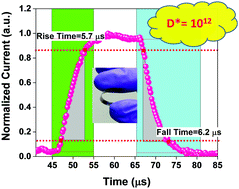Low-temperature processing of optimally polymer-wrapped α-CsPbI3 for self-powered flexible photo-detector application†
Abstract
For the application of α-CsPbI3 in optoelectronic devices, low-temperature processability and high environmental stability are critically important. Herein, we have grown a polyvinylpyrrolidone (PVP) polymer-wrapped highly stable cubic phase (α) of CsPbI3 at low temperature (60 °C) using a single step spin coating method. The optimal quantity of PVP critically facilitates precursor diffusion to form the desired phase at low temperature and concurrently renders stability to the phase. A photo-detector using a heterostructure of CsPbI3 and SnO2 on a flexible substrate is demonstrated, operating over the broad wavelength range 400–700 nm in a self-powered mode. The on/off photocurrent ratio of this self-powered flexible device is >103. The average responsivity, external quantum efficiency, and detectivity of the device are around 100 mA W−1, 25%, and 1012 Jones, respectively. The noise current of our device is 15 pA Hz−1/2 under dark conditions (at 50 mV bias) at 117 Hz frequency. The rise/fall times of the photo-detector are found to be 5.7/6.2 μs, respectively; thus showing an ultrafast response. This self-powered flexible photo-detector shows very good stability even after 500 bending cycles.



 Please wait while we load your content...
Please wait while we load your content...